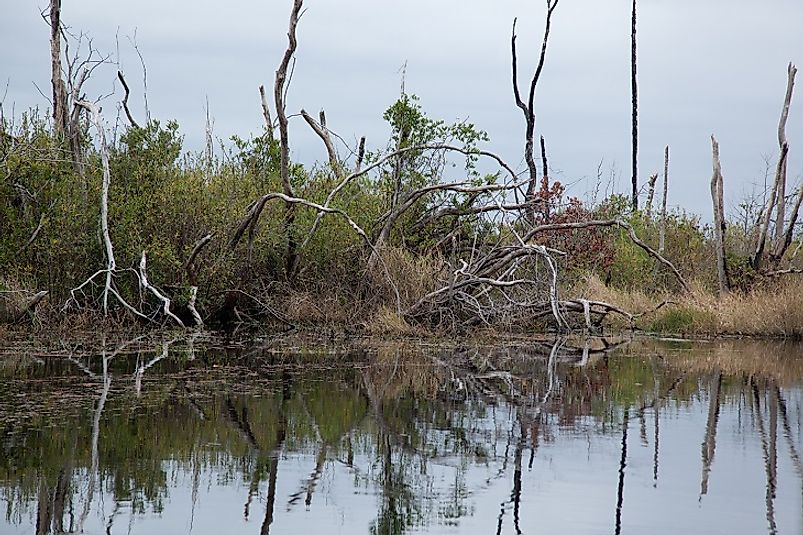The Okefenokee Blackwater Swamp

5. Description
This peat-filled wetland covers more than 400,000 acres along the border between the U.S. states of Florida and Georgia. The name Okefenokee comes from an American Indian word oka fenoke, meaning “water-shaking.” Although alligators inhabit the swampland, the shaking is due to bubbles created by decomposing plants and other organic matter from the bottom of the swamp. There are small islands floating on the Okefenokee that has formed out of the decaying vegetation bubbles and plants that have grown in the swamp. The swamp area is a partial tributary to the St. Mary's River and the Suwanee River. The two rivers ultimately drain into the Atlantic Ocean and the Gulf of Mexico, respectively.
4. Historical Role
The Okefenokee area was a relic estuary formed eons in the past, and started as part of the Atlantic Ocean. Then, about 6,500 years ago, it started accumulating peat that sank to its bottom, turning the swamp into a peat bog. There are people who live in the swamp area that outside people call, “swampers.” These “swampers” have their own peculiar way of speaking English. Isolation has kept the residents in a time-warp, retaining the Elizabethan English dialects of the original settlers who were part of the early immigrants into the New World. Today, the 438,000-acre Okefenokee Blackwater Swamp is inside the Okefenokee Wilderness and the Okefenokee National Wildlife Refuge.
3. Modern Significance
Tourism has been a way of life for the Swampers since the area was turned into a national wildlife refuge. The annual number of visitors has reached 400,000 in recent years. Tourists come from China, Mexico, Japan, the United Kingdom, France, and Germany. The area provides outdoor recreation and tours by kayak, canoe, and motorboat. Some old South traditions are still celebrated like children beauty contests and family reunions. A small number of the local people make their living by fishing in the outlying areas of the swamp while some harvest pines. Many small communities live in the surrounding area of the Okefenokee.
2. Habitat and Biodiversity
The Southeastern coniferous forest ecological region dominates the Okefenokee swamp lands, which also has upland forests and dry woodlands. Its forests have bald cypress, swamp tupelo, evergreen oaks, and long leaf pine. Carnivorous plants also thrive in the swampy areas, such as Sarracenia minor var. Okefenokeensis, Sarracenia psittacina, and the Utricularia. Numerous songbirds and several species of woodpeckers also live in the swamp trees. It also has wading birds like bitterns, egrets, ibises, cranes, and herons. The Florida black bear also roam its many habitats. Reptiles can also be seen such as alligators, snakes, frigs, turtles, and toads. Unfortunately, a string of recent wildfires have devastated large areas of the dry woodlands, totaling 600,000 acres lost when including the swamp areas.
1. Environmental Threats and Territorial Disputes
The Du Pont Company owned 16,000 acres of land in the Okefenokee and had plans to mine titanium in 1997 but, due to government and locals' opposition, abandoned the project. As a result, Du Pont donated the land it owned to The Conservation Fund in 2003. The Okefenokee is considered today as one of America's most valuable wildlife refuges, home to around 440 types of mammals, fish, amphibians, and birds. The Okefenokee has about 700 square miles of wilderness situated in southeastern Georgia. It has about 120 miles of water trails as well, with these being utilized by tourists who come to visit and enjoy the scenery and nature isolation.











